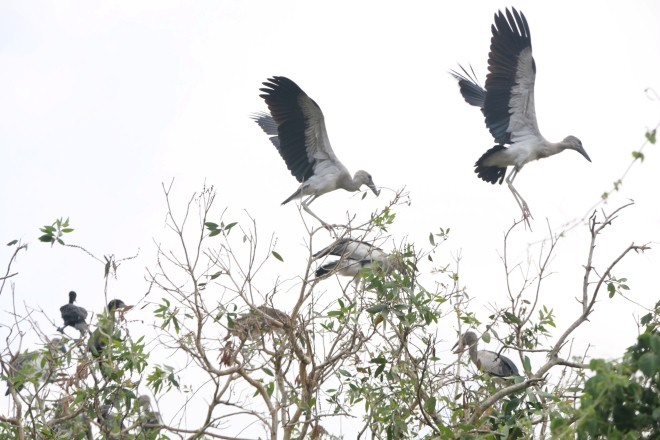Gáo Giồng Cajeput Forest protects Asian openbill storks
More than 100,000 Asian openbill storks now nesting in the Gáo Giồng Cajeput Forest in Đồng Tháp Province are receiving special protection from the forest’s management board.

More inspection sites have been set up, and people have been banned from hunting in the forest.
To provide favourable conditions for the storks, aquatic and flora species, as well as more cajeput trees and other indigenous trees, have been introduced into the forest.
Huỳnh Thanh Hiền, head of the management board, said that Asian openbill storks are listed in the rare bird category in the Việt Nam Red Data Book. The bird appears mostly in the Cửu Long (Mekong) Delta.
In the past, Asian openbill storks flew to the Gáo Giồng forest to seek food and nested in other places, but now they are nesting in the forest’s cajeput trees.
Adult Asian openbill storks weigh between one and 1.6 kilos and are about 50cm tall. Their wingspan is more than one metre. Female Asian openbill storks can lay three to four eggs per clutch.
Gáo Giồng has more than 100 bird species, including the little egret, little cormorant, painted stork, heron, black-crowned night heron and purple swamphen.
Covering a total area of 1,600ha, Gáo Giồng has 1,200ha of cajeput forests used for producing cajeput oil and wood as well as eco-tourism services.

The rare Asian openbill stork began nesting early this year in the Gáo Giồng Cajeput Forest in Đồng Tháp Province
More inspection sites have been set up, and people have been banned from hunting in the forest.
To provide favourable conditions for the storks, aquatic and flora species, as well as more cajeput trees and other indigenous trees, have been introduced into the forest.
Huỳnh Thanh Hiền, head of the management board, said that Asian openbill storks are listed in the rare bird category in the Việt Nam Red Data Book. The bird appears mostly in the Cửu Long (Mekong) Delta.
In the past, Asian openbill storks flew to the Gáo Giồng forest to seek food and nested in other places, but now they are nesting in the forest’s cajeput trees.
Adult Asian openbill storks weigh between one and 1.6 kilos and are about 50cm tall. Their wingspan is more than one metre. Female Asian openbill storks can lay three to four eggs per clutch.
Gáo Giồng has more than 100 bird species, including the little egret, little cormorant, painted stork, heron, black-crowned night heron and purple swamphen.
Covering a total area of 1,600ha, Gáo Giồng has 1,200ha of cajeput forests used for producing cajeput oil and wood as well as eco-tourism services.

Leave your comment on this story